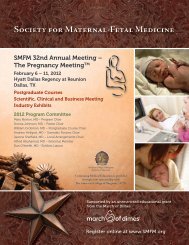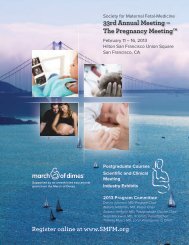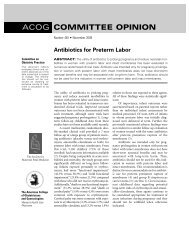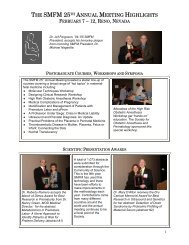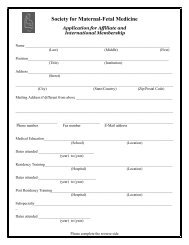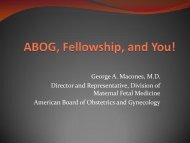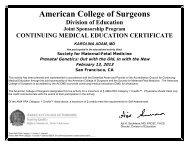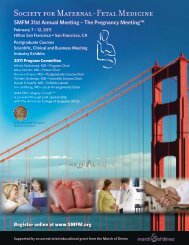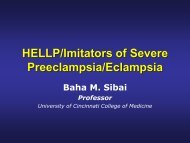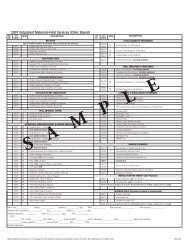Download
Download
Download
You also want an ePaper? Increase the reach of your titles
YUMPU automatically turns print PDFs into web optimized ePapers that Google loves.
Writing and Submitting your<br />
Scientific Papers<br />
Thomas J. Garite, M.D.<br />
Former E.J. Quilligan Professor and Chairman of Obstetrics and<br />
Gynecology<br />
University of California Irvine<br />
Editor in Chief, American Journal of Obstetrics and Gyencology
Publication Success<br />
Why Publish?<br />
• Fellows who do not publish during fellowship will often<br />
never take and pass their Boards<br />
• Individuals do the vast majority of completing research<br />
and writing papers in the first seven years out of<br />
fellowship.<br />
• Publication success is the single biggest indicator of<br />
academic success<br />
• Promotions<br />
• Promotions and Tenure committees place little emphasis on<br />
teaching and patient care<br />
• Division Directors and Department Chairs<br />
• Invitations to participate in committees and boards of national<br />
societies<br />
• Invitations to speak at national and international meetings
The number of unpublished studies<br />
is astounding.<br />
• Barriers to publication<br />
• Lack of mentorship<br />
• Writer’s inertia/block<br />
• Procrastination<br />
• Competing priorities<br />
• Personal<br />
• Professional<br />
• Rejection of first submission
Solutions<br />
• Barriers to publication<br />
• Lack of mentorship<br />
• Choose your mentors wisely<br />
• Experience, priority, nurturing, pushy<br />
• Writer’s inertia/block<br />
• Learn good methods for writing papers<br />
• Procrastination<br />
• Write your paper before you present it<br />
• Make it a team project<br />
• Competing priorities<br />
• Schedule specific times on your calendar to write<br />
• Rejection of first submission<br />
• Grow up – rejection is part of life<br />
• Move on – get advice on the best place for the next submission<br />
• Listen – take the advice of the reviewers before resubmission
IRB/Guidelines for Consenting<br />
Subjects for Research<br />
• Authors must follow the ethical standards for human<br />
experimentation established in the Declaration of<br />
Helsinki (World Medical Association Declaration of<br />
Helsinki: recommendations guiding physicians in<br />
biomedical research involving human subjects. JAMA<br />
1997;277:925-6).<br />
• All journals now require that you affirm IRB approval in<br />
your paper and in your cover letter<br />
• Will often require the IRB case number<br />
• Includes retrospective, chart review and data base studies<br />
• Most now also require patient consent for case reports.
Case Reports<br />
• Don’t waste your time!<br />
• VERY low acceptance rates<br />
• If you do, they must be<br />
• Highly unique, AND<br />
• Have implications for<br />
• Patient management and/or<br />
• Important future research<br />
• Example<br />
• Irwin Merkatz, low AFP in Down syndrome<br />
• Alternatively consider using the case for retrospective<br />
reviews or seeds for future studies.
Clinicaltrials.gov<br />
• ClinicalTrials.gov is a registry of federally and privately supported clinical trials conducted in the United States and<br />
around the world. ClinicalTrials.gov gives you information about a trial's purpose, who may participate, locations,<br />
and phone numbers for more details. This information should be used in conjunction with advice from health care<br />
professionals.<br />
• Find trials for a specific medical condition or other criteria in the ClinicalTrials.gov registry. ClinicalTrials.gov<br />
currently has 79,903 trials with locations in 170 countries. Get instructions for clinical trial<br />
investigators/sponsors about how to register trials in ClinicalTrials.gov. Learn about mandatory registration and<br />
results reporting requirements and US Public Law 110-85 (FDAAA). Learn about clinical trials and how to use<br />
ClinicalTrials.gov, or access other consumer health information from the US National Institutes of Health.<br />
• Resources:<br />
• Understanding Clinical Trials<br />
What's New<br />
Glossary<br />
• Study Topics:<br />
• List studies by Condition<br />
List studies by Drug Intervention<br />
List studies by Sponsor<br />
List studies by Location
Rules for Authorship<br />
Each author must qualify by having participated actively and<br />
sufficiently in the study reported. The inclusion of each author in the<br />
authorship list of a report must be based only on 1) substantial<br />
contributions to (a) the concept and design, or analysis and<br />
interpretation of data and (b) the author's having drafted the<br />
manuscript or revised it critically for important intellectual content;<br />
and 2) final approval by each author of the version of the<br />
manuscript being submitted. All conditions (1a, 1b, and 2) must be<br />
met. Others contributing to the work, including participants in<br />
collaborative trials, should be recognized separately in the<br />
Acknowledgment(s) section. In the cover letter that accompanies<br />
the submitted manuscript, it must be confirmed that all bylined<br />
authors fulfill all conditions. Accordingly, authors are encouraged to<br />
limit the number of authors listed.
Order of authors<br />
• Principle Investigator<br />
• Idea person<br />
• Last is senior author<br />
• If idea person is senior author ask him/her which is preferred<br />
• Don’t include research nurses, statisticians, ghost writers unless they fulfilled all<br />
criteria for authorship, include them as acknowledgements<br />
• Authorship<br />
Each author must qualify by having participated actively and sufficiently in the study<br />
reported. The inclusion of each author in the authorship list of a report must be based only<br />
on 1) substantial contributions to (a) the concept and design, or analysis and interpretation<br />
of data and (b) the author's having drafted the manuscript or revised it critically for<br />
important intellectual content; and 2) final approval by each author of the version of the<br />
manuscript being submitted. All conditions (1a, 1b, and 2) must be met. Others contributing<br />
to the work, including participants in collaborative trials, should be recognized separately in<br />
the Acknowledgment(s) section. In the cover letter that accompanies the submitted<br />
manuscript, it must be confirmed that all bylined authors fulfill all conditions.<br />
• GIFT AUTHORSHIP IS A SIN!<br />
• Determine order of and inclusion of authors at the BEGINNING of the study.
Abstract Submission<br />
• Where: SMFM, ACOG, SGI, AIUM<br />
• Why:<br />
• Get significant input into strengths, flaws and issue<br />
before submitting the paper<br />
• Exposure<br />
• Often more people know about your study from the<br />
presentation than from the publication<br />
• Always for junior authors, more people know who the author<br />
was than with the publication<br />
• Fun<br />
• You get priority in going to the meeting<br />
• You learn a lot more presenting than publishing
Writing an abstract<br />
• Sell the study in the introduction<br />
• Unlike papers, don’t assume the reviewer is an expert in<br />
the field – explain the problem clearly – why is the study<br />
so important<br />
• Don’t include name of the institution in the abstract<br />
• Adhere to the word limit and font size<br />
• State your primary hypothesis clearly<br />
• Don’t tell them the end points you chose in your<br />
methods section, your results will tell them<br />
• Don’t tell them what statistical methods you used.<br />
• Give them actual data<br />
• Overstate your conclusions a little more than you would<br />
in a paper.
Impact of a “rescue course” of antenatal corticosteroids (ACS): A multi-center,<br />
randomized, controlled trial.<br />
Objective:<br />
Previous studies using scheduled repetitive courses of ACS have demonstrated limited benefit and<br />
concern over potential risk. We present the first study evaluating the impact of a single “rescue” course<br />
of ACS on neonatal outcome<br />
Materials and methods:<br />
A multi-center, randomized, double blind, placebo controlled trial was performed. Eligible singletons or<br />
twins were < 33 weeks (wks), had completed a single course of betamethasone before 30 wks and at<br />
least 14 days prior, and were judged to have a recurring threat of preterm delivery in the coming week.<br />
Patients were randomized to receive a single “rescue course” of ACS or placebo. Exclusion criteria<br />
included: PROM, advanced dilation (> 5 cm), chorioamnionitis, and other steroid use. The primary<br />
outcome was composite neonatal morbidity at < 34 wks.<br />
Results:<br />
437 patients were randomized (223 study group, 214 placebo). 55% of patients in each group<br />
delivered at < 34 wks. The groups were similar in gestational age (GA) at randomization (29.4 wks)<br />
and at delivery (33.0 wks), delivery route, delivery indications, APGAR scores, cord pH, and proportion<br />
of twins. There was a significant reduction in composite neonatal morbidity < 34 wks in the “rescue<br />
steroid” group vs. placebo (42.5% vs. 63.3%, (RR 0.67, 0.54.-0.83, p=0.0002) as well as significantly<br />
decreased RDS, ventilator support, and surfactant use. Perinatal mortality and other morbidities were<br />
similar in each group. Including all neonates (regardless of GA at delivery) in the analysis still<br />
demonstrated a significant reduction in composite morbidity in the “rescue course” group (30.3 vs.<br />
41.7 (RR 0.73, 0.58-0.91, P=.0055) and improvement in other respiratory morbidities, but no other<br />
differences in outcome including head size and birth weight.<br />
Conclusions: Administration of a single “rescue course” of ACS before 33 wks improves neonatal<br />
outcome without apparent increased risk.
Writing your paper<br />
• Write the abstract for presentation first<br />
• The original protocol should essentially write your Materials and Methods<br />
• Don’t overstate what you are going to analyze in the paper – your results will<br />
define this<br />
• Be sure to state the hypothesis(ses) here.<br />
• Do the tables and figures next.<br />
• You can then decide what to keep in tabular/figure form and what to put in the<br />
wording or the results section<br />
• Demographics first<br />
• Location of study in the M and M section<br />
• Number of patients and duration of study are in the results section<br />
• Primary hypothesis data/results next<br />
• Next can be secondary or in temporal order<br />
• Write the introduction next – keep it brief<br />
• State what the issue is<br />
• What is known<br />
• Why you decided to do the study<br />
• What you studied<br />
• Discussion<br />
• See instructions for structured discussions<br />
• Abstract last
Introduction<br />
• Basic knowledge of subject<br />
• Induction of labor is an increasingly common practice in the U.S.<br />
• Remaining question<br />
• One question in performing induction is the best method of determining who will<br />
succeed<br />
• Why is it a question<br />
• Failure of induction among certain patients leads to higher c-section rates<br />
• What is currently known<br />
• Currently the best way of determining success is the Bishop score<br />
• What alternative exists<br />
• Recently some data suggest that Ffn be an indicator of the readiness of the<br />
uterus for the onset of labor and as such may be a possible indicator of who will<br />
have a successful induction of labor<br />
• Why should this be studied/Who says this should be studied<br />
• ACOG in its practice bulletin has noted that better markers of successful<br />
induction are needed<br />
• Or, since this is so common and the Bishop score only imprecisely measures<br />
success of better markers are needed<br />
• What you decided to do
Materials and Methods<br />
• Your protocol should basically write this section<br />
• General outline<br />
• Type of study – we performed a RCT of chicken soup vs. penicillin for<br />
the common cold<br />
• Primary hypothesis – chicken soup is at least as good as penicillin<br />
• IRB approval – was obtained from WIRB for all sites<br />
• Eligible subjects<br />
• Exclusions<br />
• Randomization<br />
• End points<br />
• Data safety monitoring committee<br />
• Adverse events<br />
• Interim analyses<br />
• Statistics<br />
• Sample size<br />
• Based on what premises<br />
• Type of statistics<br />
• Don’t say what you studied unless it is not included in the results section or<br />
unless you need to define the end points – e.g. composite morbidity.<br />
• Software used for statistics
Results<br />
• Duration, dates<br />
• Location(s)<br />
• Describe population – high risk for ?, private practice,<br />
middle west, etc<br />
• How many studied, why<br />
• Flow sheet if RCT<br />
• How many in each group<br />
• Demographics<br />
• Primary end point outcome<br />
• Secondary end point(s) outcome<br />
• Temporal order
• Health economics. In addition to the general instructions for authors and other guidelines<br />
applicable to their study (eg, CONSORT guidelines for a randomized, controlled trial), authors of<br />
health economics manuscripts should consider the following issues specific to such studies and<br />
address them in the manuscript and/or submission letter. A health economics checklist is to be<br />
included with the general manuscript checklist at the time of submission.<br />
Guidelines for Specific Types of Reports<br />
Trial and research guidelines<br />
The following guidelines must be adhered to when formulating the study. Upon submitting the<br />
manuscript, authors are to indicate on the Submission Checklist the type of trial/research used.<br />
• Randomized controlled trial. Authors are to consult the revised CONSORT statement (Moher<br />
D, Schulz KF, Altman D, for the CONSORT Group. The CONSORT Statement: revised<br />
recommendations for improving the quality of reports of parallel-group randomized trials. JAMA<br />
2001;285:1987-91). A flowchart as a figure must be submitted in the manuscript.<br />
• Meta-analysis or systematic review of randomized controlled trials. Authors are to<br />
consult the QUOROM statement (Moher D, Cook DJ, Eastwood S, Olkin I, Rennie D, Stroup DF,<br />
for the QUOROM Group. Improving the quality of reports of meta-analyses of randomized<br />
controlled trials: the QUOROM statement. Quality of Reporting of Meta-analyses. Lancet<br />
1999;354:1896-1900).<br />
• Meta-analysis or systematic review of observational studies. Authors are to consult the<br />
MOOSE guidelines (Stroup DF, Berlin JA, Morton SC, et al, for the Meta-analysis of Observational<br />
Studies in Epidemiology [MOOSE] group. Meta-analysis of observational studies in epidemiology:<br />
a proposal for reporting. JAMA 2000;283:2008-12).<br />
• Diagnostic tests. Authors are to consult the STARD Initiative (Bossuyt PM, Reitsma JB, Bruns<br />
DE, et al., for the STARD Group. Towards complete and accurate reporting of studies of<br />
diagnostic accuracy: the STARD
Flow Sheets<br />
• In preparing a study, don’t forget to keep track<br />
of all patients approached and eligible<br />
• Eligible<br />
• Approached<br />
• Declined<br />
• Consented<br />
• Withdrawn – reasons<br />
• Lost to follow up – reasons<br />
• Included<br />
• Analyzed<br />
• Not analyzed.
RCT of Dextrose and its effect on labor<br />
Shrivistava et al<br />
300 Subjects<br />
Randomized<br />
289 Subjects<br />
Analyzed<br />
Excluded:<br />
- Incomplete Data (3)<br />
- Withdrawn (5)<br />
- Did not meet criteria (3)<br />
•Maternal age < 18 yr<br />
(1)<br />
•Diabetic (1)<br />
•Preeclamptic (1)<br />
Normal Saline<br />
n = 97<br />
5% Dextrose in<br />
Normal Saline<br />
n = 94<br />
10% Dextrose in<br />
Normal Saline<br />
n = 98<br />
Neonatal Data<br />
n = 81<br />
Neonatal Data<br />
n = 85<br />
Neonatal Data<br />
n = 82
Structured Discussion<br />
• • Statement of principal findings<br />
• • Strengths and weaknesses of the study<br />
• • Strengths and weaknesses in relation to other<br />
studies, discussing particularly any differences in<br />
results<br />
• • Meaning of the study: possible mechanisms and<br />
implications for clinicians or policymakers<br />
• • Unanswered questions and future research
Choosing a Journal<br />
• Audience<br />
• Subspecialty, general<br />
• Prestige<br />
• Study’s Impact<br />
• Likelihood of acceptance<br />
• Connections??<br />
• Impact Factor, Citation Index
Suggested Reviewers<br />
• Upon submitting a manuscript, authors are required to provide the<br />
name, address, and e-mail address of at least 3 potential reviewers<br />
for editorial consideration. Suggested reviewers may include anyone<br />
knowledgeable in the area of study presented. Authors should not<br />
knowingly recommend as a potential reviewer a person with a<br />
potential conflict of interest, either financial or personal (positive or<br />
negative bias), such as a mentor or close associate. Additionally, the<br />
authors should not recommend any individuals located at the same<br />
institution as any of the authors.<br />
• Other facts<br />
• Editors variably use suggested reviewers<br />
• Authors may ask certain reviewer(s) not be used<br />
• Average acceptance of a reviewer invitation is about 60%<br />
• Junior reviewers provide better reviews than senior reviewers<br />
• Quality of the review is taken into account in editor’s decision<br />
• Ask advice from an expert in the particular area and an expert in<br />
journal editing
Ethical Imperative to be a Reviewer<br />
• If you want your papers reviewed, then you<br />
should be willing to return the favor<br />
• If you want fair, constructive, authoritative<br />
reviews you should provide this kind of review<br />
• Exposure<br />
• You learn how to write a paper by doing reviews<br />
and seeing what others do right and wrong<br />
• You share the knowledge you have acquired<br />
with others writing papers<br />
• Ultimately patient outcome is improved.
Process of review<br />
• Read through paper<br />
• Does it address important topic<br />
• Appropriate design?<br />
• Clear presentation?<br />
• Evaluate each section of paper<br />
• Title<br />
• Aim<br />
• Clearly stated<br />
• Important to journal
Evaluate methods<br />
• Study design appropriate for aim?<br />
• Sample size calculation<br />
• Is it clear<br />
• Do statistics seem correct
Evaluate Results, Figures,<br />
Tables<br />
• Clear, orderly<br />
• Tables and figures clear<br />
• Do they add anything<br />
• Are the results duplicated in text and tables
Evaluate Conclusions<br />
• Should highlight authors results<br />
• how data fit into literature<br />
• why important<br />
• Should be succinct<br />
• not over reaching<br />
• not too repetitive with the introduction
Evaluate the Abstract<br />
• Do this after you have critiqued the<br />
paper<br />
• Make sure abstract is accurate with<br />
paper
SCIENTIFIC MERIT: Quality of the science, adequacy of the sample size, hypothesis<br />
adequately stated and tested, and interpretation of the results<br />
ORIGINALITY: Is the paper addressing a question not studied, or inadequately studied<br />
in the past?<br />
IMPORTANCE: Do the findings of the paper have significance in answering an important<br />
clinical question; either with immediate applicability, or in directing future research<br />
which will do so?<br />
READERSHIP INTEREST: Will this article be of interest to a majority of AJOG readers?<br />
QUALITY: Is the Abstract sound & precise; Introduction brief & suitable; Results clearly<br />
presented with appropriate tables/figures; Discussion through & sound, Statistics &<br />
References appropriate, and is the overall paper well-written & understandable?
Pearls<br />
• Oversell your abstract, undersell your paper<br />
• Get advice from someone who has had abstracts and papers written and accepted<br />
• Establish authorship when you design your study – both who and order of authorship<br />
• Have someone outside the group of authors read your abstract/paper before<br />
submission<br />
• Don’t forget to involve people in the department (early in the study) who are experts<br />
in the area<br />
• Don’t oversell results of secondary analyses<br />
• Don’t succumb to pressures real or perceived to include authors not really eligible<br />
• Write you abstract first, then the paper, then do the presentation<br />
• Read the Information for Authors thoroughly<br />
• Do your literature search first when designing the study, intermittently during the<br />
study and again when writing the abstract/paper – don’t forget clinicaltrials.gov<br />
• Always have all authors read and approve abstract/paper before submitting and all<br />
revisions as well<br />
• Brevity reigns!<br />
• Don’t hesitate to call Journal staff or write editors with questions<br />
• Prepublication consults are good things!
Inappropriate Acts<br />
• Fabrication<br />
• Falsification<br />
• Plagiarism<br />
• Repetitive publication<br />
• Violation of government rules of research<br />
• Failure to retain original data<br />
• Gift or honorary authorship<br />
• Conflict of interest<br />
• Order of authorship
Five Year Comparison<br />
Original Research Articles Received<br />
2003 - 2007<br />
1000<br />
950<br />
992<br />
997<br />
900<br />
850<br />
800<br />
932<br />
898<br />
856<br />
750<br />
2003 2004 2005 2006 2007<br />
ORIGINAL RESEARCH PAPERS
Manuscripts processed in 2007<br />
Original Research Manuscripts<br />
Received in 2007 = 997<br />
Decisions made in 2007<br />
Accepted = 287 (29%)<br />
Declined = 718 (71%)
Acceptance Rates Regular<br />
Non-Society Articles<br />
45<br />
40<br />
35<br />
30<br />
25<br />
20<br />
15<br />
10<br />
5<br />
0<br />
43<br />
37<br />
32<br />
29 29<br />
2003 2004 2005 2006 2007
Five-Year Comparison of Domestic<br />
and Non-Domestic Published<br />
Articles 2003 - 2007<br />
466<br />
500<br />
450<br />
400<br />
380<br />
400<br />
358<br />
338<br />
Number of Articles<br />
350<br />
300<br />
250<br />
200<br />
150<br />
100<br />
210<br />
218<br />
193<br />
175<br />
133<br />
50<br />
0<br />
2003 2004 2005 2006 2007<br />
USA<br />
FOREIGN
Editorial Review Time<br />
• Assign Reviewers/Reject without Review (5<br />
days)<br />
• Reviews Completed to Editors Decision (37<br />
days)<br />
• Revisions by Authors (44 days)<br />
• Decision on Revisions (5 days)<br />
Total days from submission to INITIAL Acceptance = (92.6 days)
Reviewers Time Alloted<br />
• Invitation to Review<br />
• Time allowed to respond – 7 days<br />
• Reminder – 5 days<br />
• Uninvite – past 7 days<br />
• Perform the review<br />
• Time allowed – 14 days<br />
• Reminder – 9-10 days<br />
• Past due – at 14 days
Reviewer Assignment to Editor<br />
Revise Decision<br />
MS completed within # days<br />
# of<br />
papers %<br />
Average = 37.1 days<br />
30 days 77 32.90%<br />
60 days 121 51.70%<br />
90 days 29 12.40%<br />
More than 90 days (91-148 days) 7 3.00%<br />
Totals 234 100.00%
Current Status (cont.)<br />
• Publication Process<br />
• Summary Production (26 days)<br />
• Summary approval by author (18 days)<br />
• Summary approval by editor (5 days)<br />
• Final Acceptance (released to production) to<br />
Publication (148 days / 4.9 months)<br />
Total days from submission to publication<br />
(316 days / 10 months)




